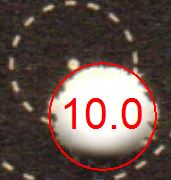This week’s feature story comes to us courtesy of Erik Anderson Ph.D. of Orion Scoring Systems. I learned some things about decimal target scoring and thought you would also enjoy this excellent primer.
By: Erik Anderson Ph.D.

Many coaches, athletes, and spectators may not be familiar with ‘decimal scoring.’ Decimal scoring, after all, is relatively new to the shooting sports. It is when the scoring rings on a target are further divided down into 10 sub-rings. Instead of having scores like 10s, 9s, and 8s as is done with integer scoring, with decimal scoring you have scores like 10.2s, 9.8s, and 8.4s.
With decimal scoring, the highest value shot is a 10.9; this is a shot that is very nearly perfectly centered on the target. A 10.0 is a shot that just barely hits the 10 ring. A 9.9 is a shot that is just outside of the 10 ring. In a ten shot series, a perfect score would be 109.0. This, to our knowledge, has never been done. The top air rifle athletes in the world, though, average scores in the 105.0 to 106.0 range, and sometimes better.

A great advantage of decimal scoring is that the difference between a 10.0 and a 9.9 is only .1 points. Consider two athletes, the first fires five 9.9s in a row. The second fires five 10.0s in a row. With decimal scoring, the score difference is just .5 points. But in integer scoring, the difference would be a whopping 5 points, despite the fact the shots were nearly the same distance from the center.
Integer scoring has been around for over a century. It was invented in the late 19th century with the adaptation of the 10 ring target. At the time, this was a bit of a technological breakthrough. For the first time, the value of any single shot could be quantified beyond just hit or miss. For nearly 100 years it was the best method the sport had to measure athlete performance. It routinely and correctly identified the top shooter at any given match. But as time went on, athletes got better and a new approach had to be invented.

Decimal scoring began widespread use after the 1984 Olympics and implemented to score Finals. At the time, all Rifle and Pistol events had the top 8 athletes after qualification come back and shoot 10 additional shots. This is known as the Finals. The scores fired in the Final, scored in decimal, were added to the qualification score to determine the winner. Decimal scoring was used then because it helps reduce ties and is more exciting to spectators.
Recently, decimal scoring has been adopted for all Air Rifle and 50m Prone qualification events internationally. The reason was simple. Athletes became so good that perfect scores, or scores 1 or 2 points shy of perfect, were routine. Differentiating between all these great scores was impossible. By adopting decimal scoring, the athlete performances could once again be separated and the best athlete named!
Today, here in the United States, decimal scoring is used by USA Shooting and the National Three-Position Air Rifle Council in all standing air rifle events. It was used successfully in the 2018 Daisy National BB Gun Championships. And it is used in practically all Rifle and Pistol Finals events (25m Pistol events technically use a hit-miss format in Finals, but this is based on decimal values).
There are many advantages to decimal scoring. It is more exciting to spectators and the top athletes’ performances can be differentiated helping to make sure the best athlete or team wins. Decimal scoring also reduces the luck involved in scoring, reduces the number of ties, and is a more precise way of measuring scores.
The move to more precision in scoring is not unique to shooting. Sports such as downhill skiing, luge, and track and field have all moved to more precise timing. Decades ago these sports were timed with tenth of a second precision (.1s). Then hundredth of a second precision (.01s), and now scored with thousands of a second precision (.001s). Shooting’s move to decimal scoring fits the pattern of better precision adopted by other sports.
Decimal scoring is quite simply the modern way to score targets. With the added precision it makes matches more fair to the athletes, and goes a long way to help make sure the best athlete wins.
